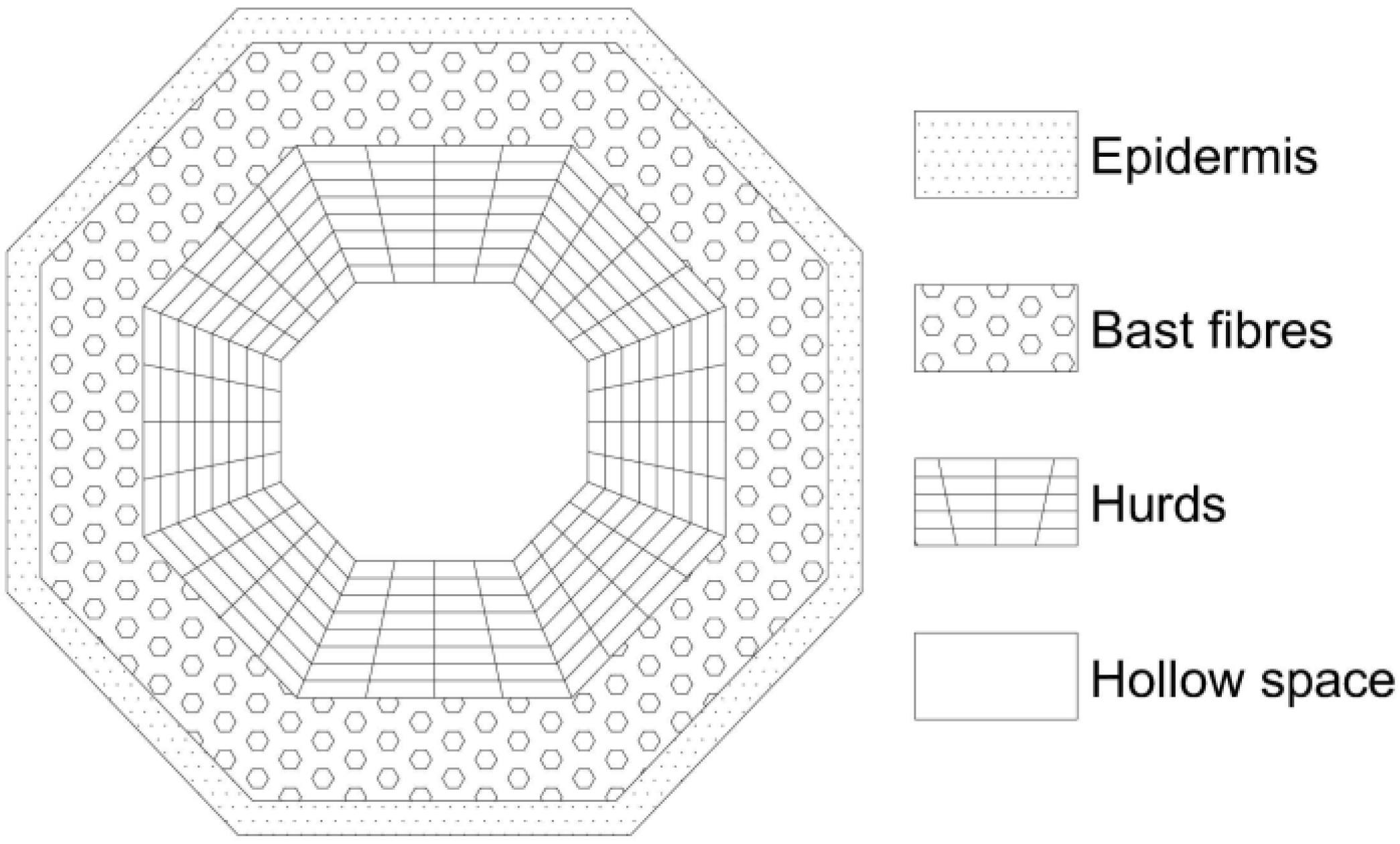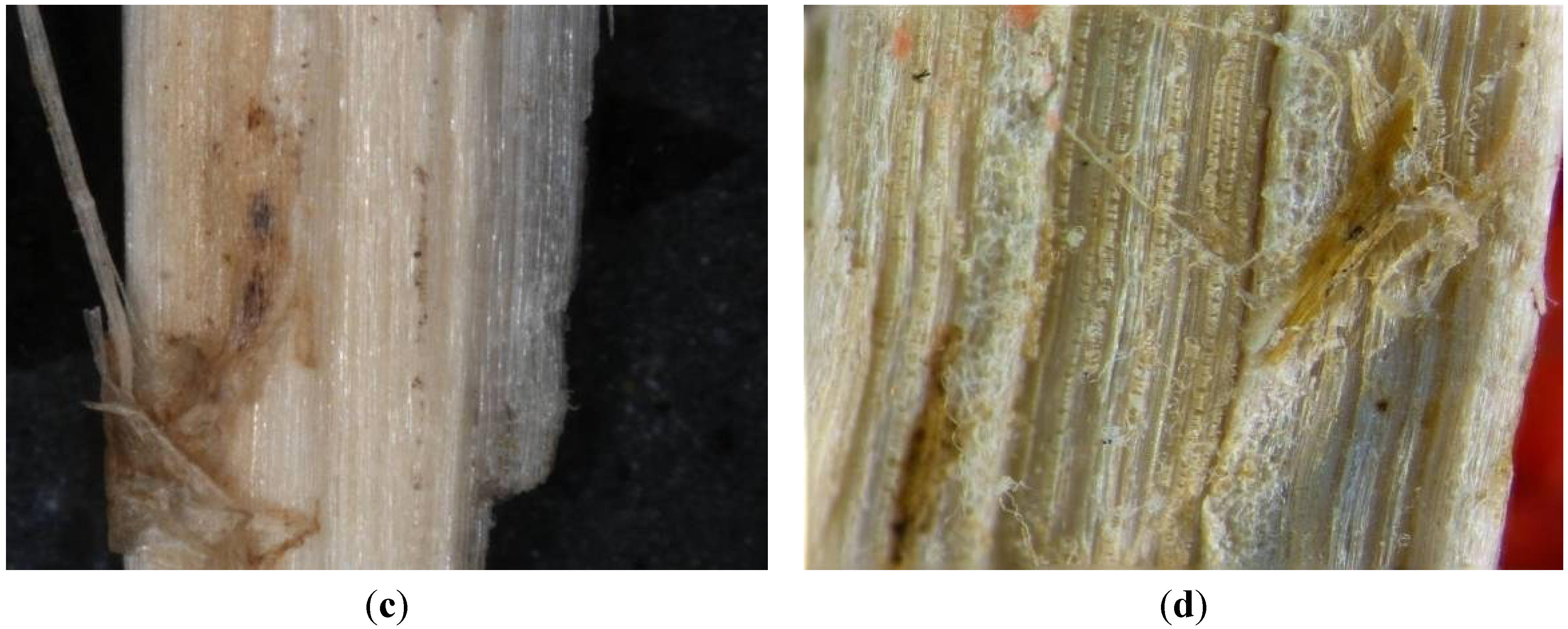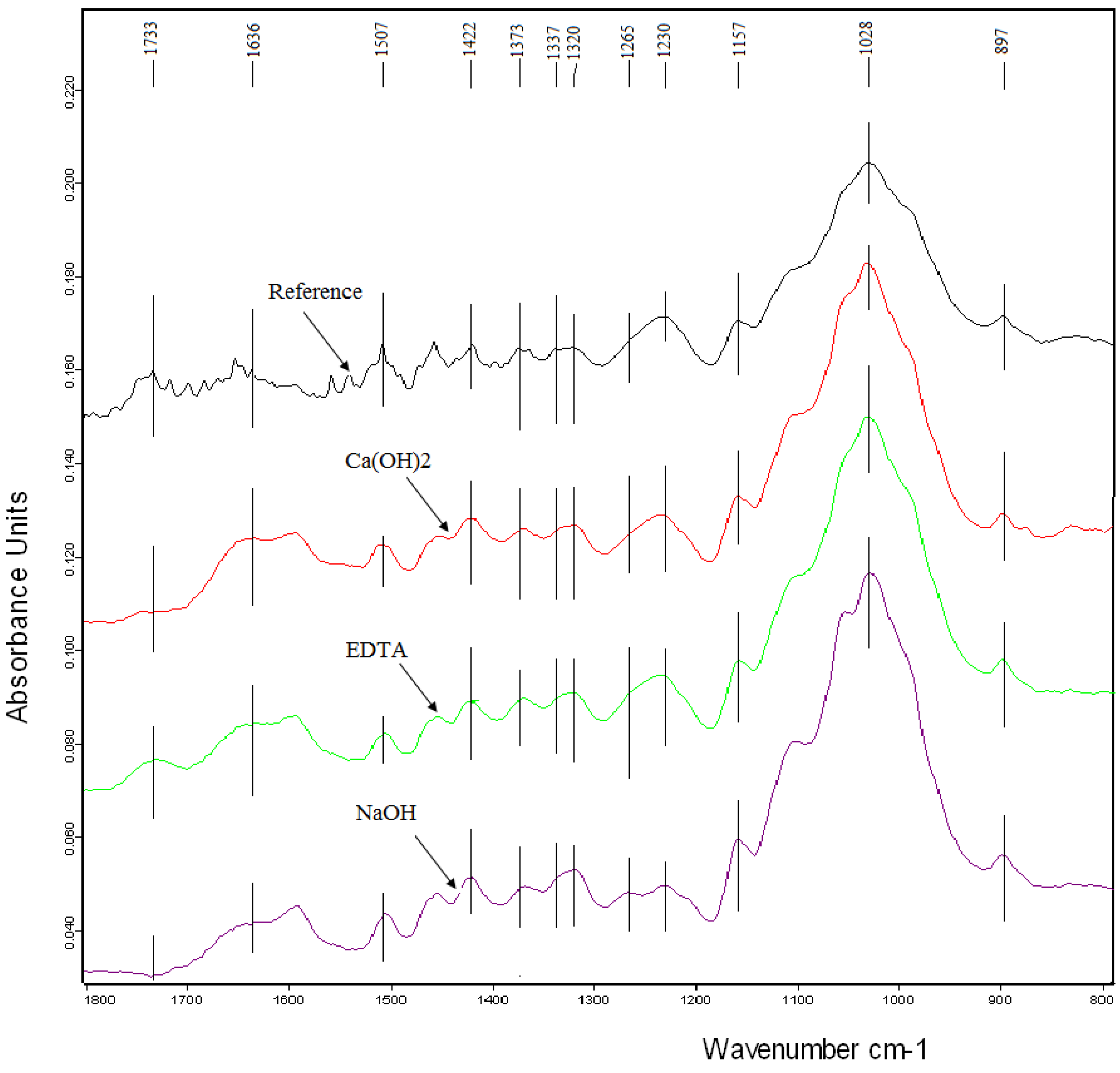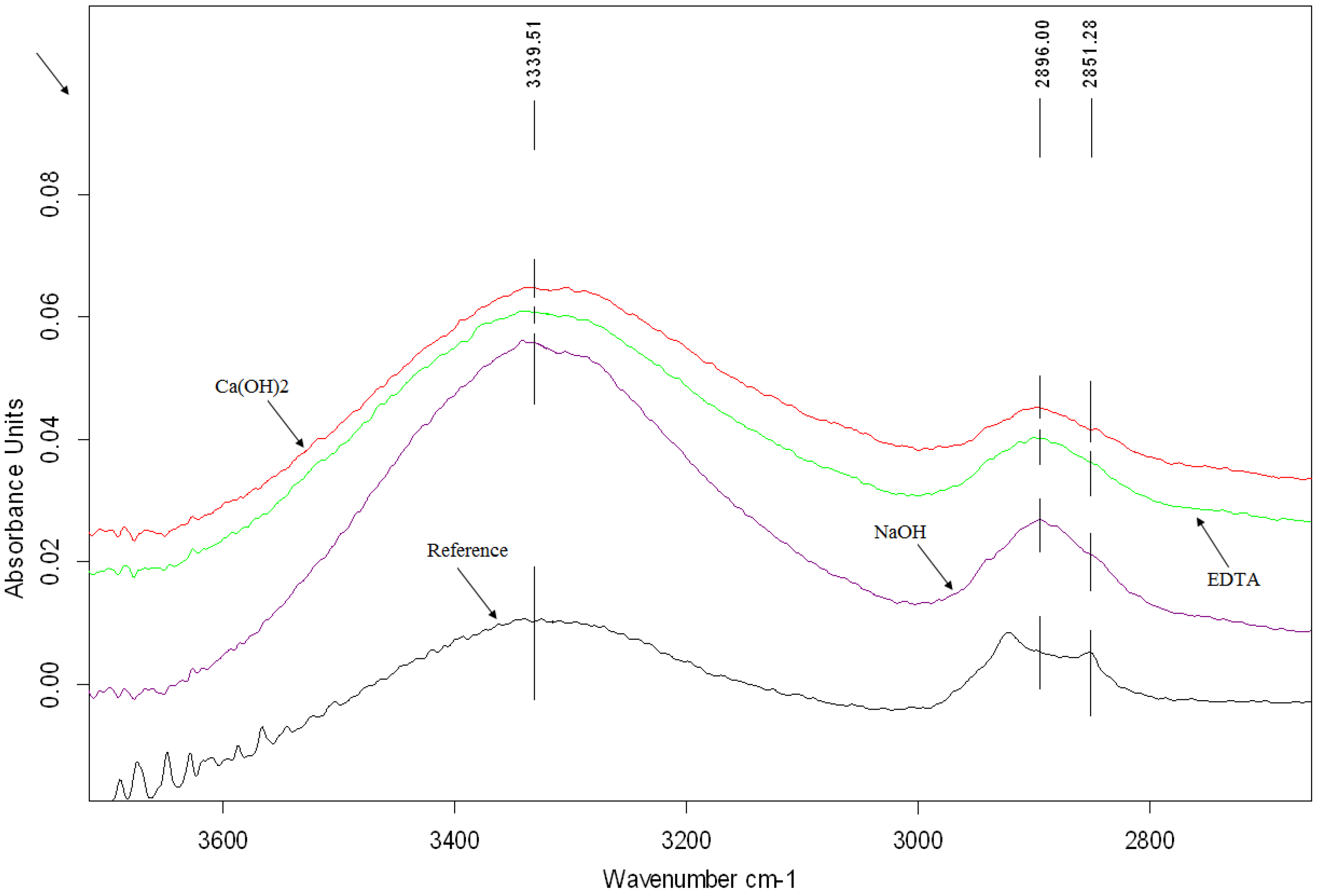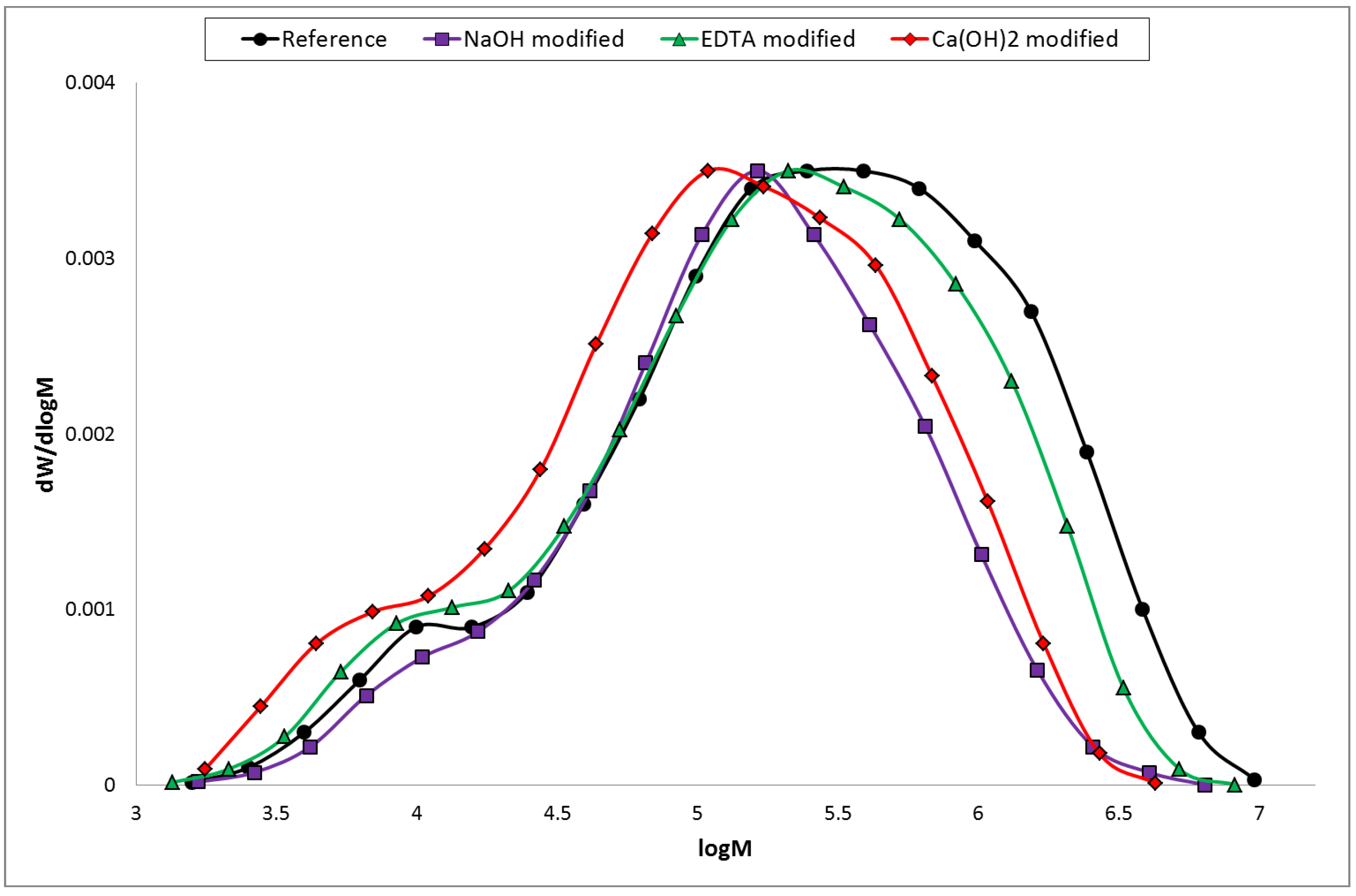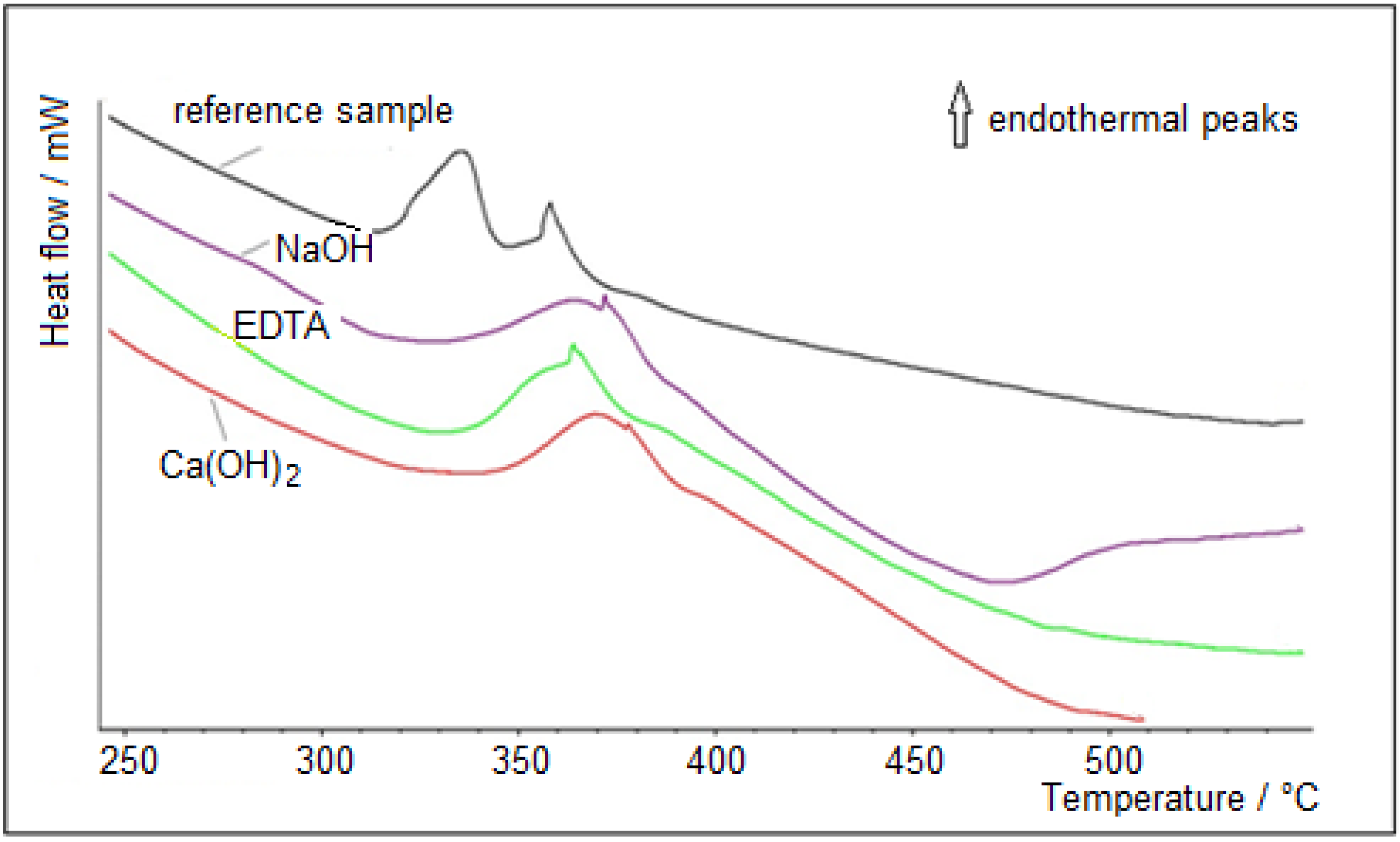1. Introduction
Composites derived from natural and fast renewable resources, especially cellulosic materials, are increasing in importance due to their numerous advantageous properties for application in sustainable building constructions. The composites require a strong fiber with good adhesion between matrix and fiber to enhance their final properties. Substantial research work has been conducted on fiber reinforced concrete primarily made of a mix of hydraulic cement, aggregates, water, and reinforcing fibers. Fibers used are typically synthetic industrial such as steel, polypropylene, nylon, and glass. Adding such materials to concrete should result in a randomly, discrete, and discontinuous orientation of fibers whose main function is to bridge across cracks that develop in concrete. Thus, fiber reinforced concrete is expected to satisfy the strength, ductility, and durability requirements of a high performance concrete material [
1]. In the scientific sphere as well as in industrial production, the use of natural lignocellulosic fibers (such as sisal, jute, bamboo, coconut, coir, kenaf, hemp,
etc.) as a replacement for synthetic fibers into composites has received attention in recent years. One of the aspects of using hemp products in building industry is they are more environmentally friendly in comparison to conventional materials (conventional insulating materials-polystyrene, mineral wool and materials based on cement binders and other).
Considerable efforts have been made to develop natural fiber-reinforced cement composites for affordable infrastructures. However, the long-term durability of natural fiber-reinforced composites is limited due to their high permeability and lack of resistance to crack growth, particularly fibers obtained from agricultural by-products [
2,
3]. A major problem in plant fibers compared to synthetic fibers is missing homogeneity of the material and hydrophility of natural fibers resulting in high moisture absorption.
The technical hemp (Cannabis Sativa L.) is the source of two types of natural fibers: bast fibers (used mainly in the paper and textile industries) and woody core fibers—hurds. Hemp stem consists of approximately 20 wt%–40 wt% of bast fibers and 60 wt%–80 wt% of hurds [
4]. The hurds consist of 40%–48% cellulose, 18%–24% hemicellulose and 21%–24% lignin. The bast fibers contain higher amounts of cellulose (57%–77%) and content of hemicellulose (9%–14%) and lignin (5%–9%) is lower compared to woody core fibers [
5]. A cross section of the hemp stem shows its complex structure of different layers preset in stem (
Figure 1). The outside of the stem is covered with bark, also called epidermis. Inside the hemp stems are bast fibers and hurds. The bast fibers are joined together by a middle lamella, mainly composed of pectin and arranged in bundles forming a ring around the outer part of the stem. Each fiber bundle consists of single fibers. There are two types of fibers, the useful primary fibers (5–55 mm long) and the short secondary fibers (2 mm long). The bast fibers are 10 to 100 times longer than the woody fibers in the hurds. Their diameters are approximately the same; however the cell walls of the bast fibers are 5 to 10 times thicker than those of woody fibers. The fiber content is given in relation to the weight of the whole stem [
6]. In contrast to the high quality of bast fibers, the hurds is the least valuable part of the plant, chemically very close to wood.
Figure 1.
Cross-section of a hemp stem [
6].
Figure 1.
Cross-section of a hemp stem [
6].
Hemp can play a vital role in the move towards organic agriculture. This plant is easy to grow. For its growth it needs no chemical fertilizers and herbicides. Growth conditions have a huge influence on the production of plant fibers [
7].
Growing interest in using hemp hurds as waste material from bast fibers production in lightweight composite preparation is recorded in recent years [
8,
9]. Interesting properties such as thermal, mechanical, acoustic and aseptic including low density, biodegrability, low costs and ecological suitability of this plant raw material predetermine to use it in function of organic filler in composite. In our previous papers [
10,
11,
12], experimental study of the parameters affecting the physical and mechanical properties of hemp composite based on conventional and alternative binders was performed with emphasis on an assessment of the possibility using industrial hemp as a source of natural fibers for purpose of construction. However, high moisture sorption and heterogeneity of hemp fibers cause weak adhesion of the fibers and the matrix in composite system and a poor transfer of the applied stress between the filler and binder materials, what was confirmed in [
13]. Indeed, due to the highly porous structure of hemp and its strong capillarity effects inside the tubes, hemp is able to absorb large amounts of water (up to five times its own weight). On the other hand, this hemp ability to regulate humidity inside buildings by absorbing and/or releasing water depending on air conditions cannot be neglected [
14].
Many research projects have been devoted to the enhancement of the adhesion at the fibers–matrix interface by using chemical modifications of the surface of fibers the [
15,
16] or physical treatment of hemp fibers [
17,
18]. Whereas the benefits of surface treatments of natural fibers on the fiber–polymer matrix interfacial properties were intensively studied and are known, the potential positive effect of chemically treated of hemp hurds on fiber/inorganic matrix interface has not been systematically studied, especially not in the case of alternative inorganic binder such as MgO–cement. The influence of chemical modification on strength parameters as well as behavior of composites based on modified hurds with alternative binder of MgO–cement was investigated in our previous papers [
19,
20]. Changes in chemical composition of hemp hurds affect the properties of the resulting composite, which is produced by incorporating biomass into the composite system. Therefore, knowledge of the chemical changes in organic filler achieved by treatment is necessary for clarifying its behavior in interaction with inorganic matrix and it is very important for understanding the possible effects on final physical and mechanical properties of hardened composites based on chemically modified hemp hurds. In this article, complex study of the changes in surface morphology, chemical composition and structure of hemp hurds after chemical modification in three medium have been characterized by using of various methods (FTIR (Fourier Transform infrared spectroscopy), XRD (X-ray powder diffraction analysis) and TG (thermogravimetry)/DSC (differential scanning calorimetry) and SEC (Size exclusion chromatography) and compared to reference (unmodified) hemp hurds.
4. Conclusions
Experiments were conducted to characterize the changes in the properties of hemp hurds after its chemical modification in three solutions (NaOH, EDTA and Ca(OH)2) by using physic-chemical methods in terms of the potential use of this natural material as filler in composite materials.
The most significant changes in defibrillation of bundles, chemical and phase composition and cellulose crystallinity were recorded in the case of alkaline treated hemp hurds sample. Decrease in lignin and hemicellulose content was obtained. Content of polysaccharides component (holocellulose) was lower in comparison to referential sample due to degradation of hemicelluloses.
The highest value of crystallinity index of cellulose calculated from both FTIR and XRD methods was detected after NaOH treatment of hemp hurds. The results of CIFTIR and CIXRD are in a strong correlation. Based on the presented results and in accordance with literature, FTIR method seems be more useful for crystallinity evaluation of cellulose in natural lignocellulosic material.
Chemical treatment led to decrease in degree of polymerization of cellulose. A good correlation between degree of polymerization and crystallinity index (CIFTIR) of cellulose for all hemp hurd samples was obtained. NaOH treatment of hemp hurds led to a significant decrease in polydispersity index in comparison to reference sample due to the degradation of high molecular weight fractions of cellulose. Water absorbability of hemp hurds has been enhanced after chemical treatment. The obtained results confirmed that water behavior depends on chemical composition of hemp hurd samples.
Thermal stability of chemically modified hemp hurd samples was higher than in the case of reference sample.
Such an approach based on knowledge of the changes in morphology, chemical composition and structure of hemp hurds after chemical treatment is very beneficial for the preparation of composite materials of progressively higher performance in terms of improvement of filler/matrix interface properties.
